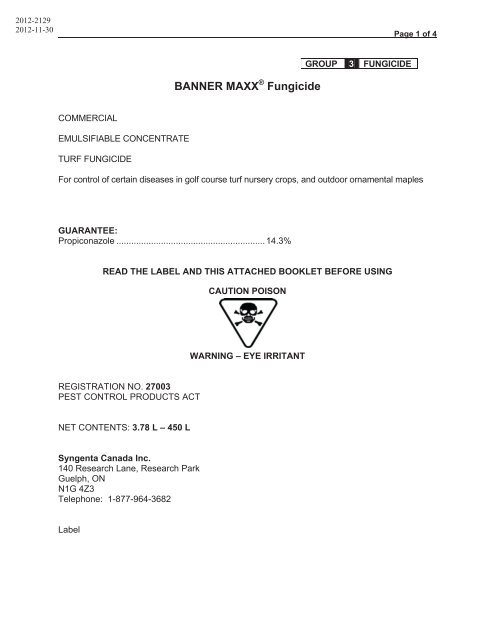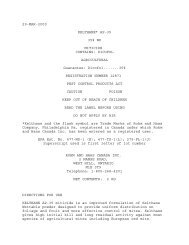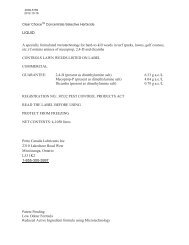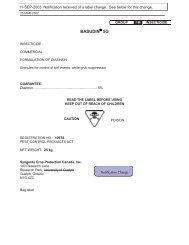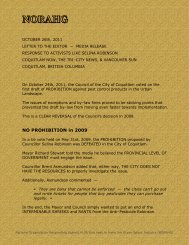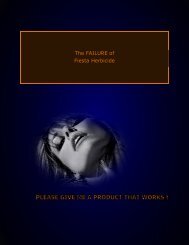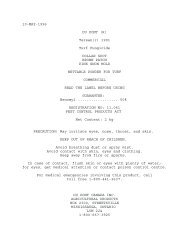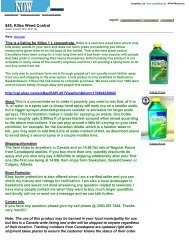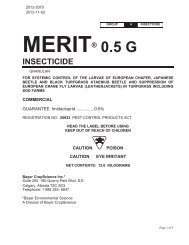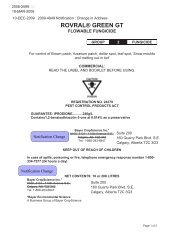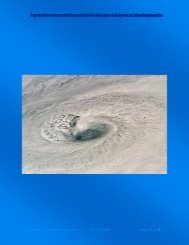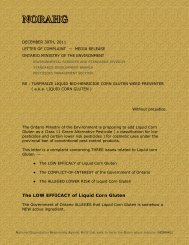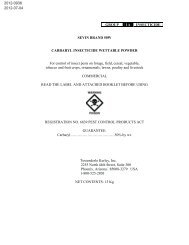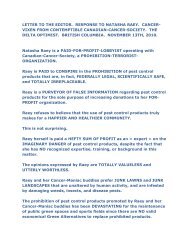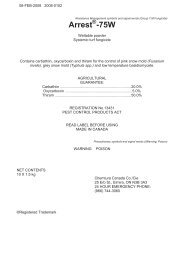Label â Banner MAXX Fungicide
Label â Banner MAXX Fungicide
Label â Banner MAXX Fungicide
You also want an ePaper? Increase the reach of your titles
YUMPU automatically turns print PDFs into web optimized ePapers that Google loves.
2012-2129<br />
2012-11-30<br />
Page 1 of 4<br />
BANNER <strong>MAXX</strong> ® <strong>Fungicide</strong><br />
GROUP 3 FUNGICIDE<br />
COMMERCIAL<br />
EMULSIFIABLE CONCENTRATE<br />
TURF FUNGICIDE<br />
For control of certain diseases in golf course turf nursery crops, and outdoor ornamental maples<br />
GUARANTEE:<br />
Propiconazole ............................................................ 14.3%<br />
READ THE LABEL AND THIS ATTACHED BOOKLET BEFORE USING<br />
CAUTION POISON<br />
WARNING – EYE IRRITANT<br />
REGISTRATION NO. 27003<br />
PEST CONTROL PRODUCTS ACT<br />
NET CONTENTS: 3.78 L – 450 L<br />
Syngenta Canada Inc.<br />
140 Research Lane, Research Park<br />
Guelph, ON<br />
N1G 4Z3<br />
Telephone: 1-877-964-3682<br />
<strong>Label</strong>
Page 2 of 4<br />
NOTICE TO USER<br />
This pest control product is to be used only in accordance with the directions on the label. It is<br />
an offence under the Pest Control Products Act to use this product in a way that is inconsistent<br />
with the directions on the label. The user assumes the risk to persons or property that arises<br />
from any such use of this product.<br />
FIRST AID<br />
IF POISONING IS SUSPECTED, IMMEDIATELY contact a physician or a poison control centre.<br />
Take container, label or product name and Pest Control Product Registration Number with you<br />
when seeking medical attention.<br />
IF SWALLOWED, call a poison control centre or doctor IMMEDIATELY for treatment advice.<br />
Have person sip a glass of water if able to swallow. Do not induce vomiting unless told to do so<br />
by a poison control centre or doctor. Do not give anything by mouth to an unconscious person.<br />
IF IN EYES, hold eye open and rinse slowly and gently with water for 15–20 minutes. Remove<br />
contact lenses, if present, after the first 5 minutes, then continue rinsing eye. Call a poison<br />
control centre or doctor for treatment advice.<br />
IF ON SKIN OR CLOTHING, take off contaminated clothing. Rinse skin IMMEDIATELY with<br />
plenty of water for 15–20 minutes. Call a poison control centre or doctor for treatment advice.<br />
IF INHALED, move person to fresh air. If person is not breathing, call 911 or an ambulance,<br />
then give artificial respiration, preferably by mouth-to-mouth, if possible. Call a poison control<br />
centre or doctor for further treatment advice.<br />
TOXICOLOGICAL INFORMATION<br />
Note to Physician: There is no specific antidote for this product. Treat symptomatically.<br />
PRECAUTIONS<br />
o<br />
o<br />
o<br />
o<br />
o<br />
o<br />
o<br />
o<br />
o<br />
KEEP OUT OF THE REACH OF CHILDREN.<br />
KEEP PEOPLE OFF TREATED AREA UNTIL FOLIAGE IS DRY.<br />
Harmful if swallowed. Causes eye irritation. DO NOT get in eyes.<br />
Wear long pants, a long sleeve shirt, shoes and socks and chemical resistant gloves during<br />
mixing/loading, application, clean-up and repair activities.<br />
DO NOT use leather or cloth gloves. Rinse gloves with soap and water before removal and<br />
wash hands.<br />
Wear protective goggles or face shield as well as a protective apron when handling the<br />
concentrated product during mixing and loading.<br />
Do not eat, drink or smoke during application; wash hands and face thoroughly immediately<br />
following each application of this product.<br />
Immediately wash off accidental splashes of the concentrate or spray mixture from skin,<br />
clothing and eyes.<br />
After work, change clothing and wash entire body thoroughly.
Page 3 of 4<br />
o Wash contaminated clothes separately from other laundry before reuse.<br />
o Do not contaminate food or feed.<br />
o Do not graze livestock on treated areas.<br />
o Do not feed clippings from treated areas to livestock or poultry.<br />
o This pesticide is toxic to fish and other aquatic organisms. Do not spray any body of water by<br />
direct application, drift or by cleaning and rinsing spray equipment.<br />
o Do not use or store near heat or open flame.<br />
o DO NOT allow entry into treated area for 12 hours following application. See the<br />
DIRECTIONS FOR USE section for crop specific restricted entry intervals.<br />
DO NOT APPLY BY AIR.<br />
ENVIRONMENTAL HAZARDS<br />
Toxic to aquatic organisms and non-target terrestrial plants. Observe buffer zones specified<br />
under DIRECTIONS FOR USE.<br />
The use of this chemical may result in contamination of groundwater particularly in areas where<br />
soils are permeable (e.g. sandy soil) and/or the depth to the water table is shallow.<br />
To reduce runoff from treated areas into aquatic habitats avoid application to areas with<br />
moderate to steep slope, compacted soil, or clay.<br />
Avoid application when heavy rain is forecast.<br />
Contamination of aquatic areas as a result of runoff may be reduced by including a vegetative<br />
strip between the treated area and the edge of the water body.<br />
Toxic to certain beneficial insects. Minimize spray drift to reduce harmful effects on beneficial<br />
insects in habitats next to the application sites such as hedgerows and woodland.<br />
STORAGE<br />
1. Do not use or store near heat or open flame.<br />
2. Keep from freezing.<br />
3. Store in original container in a secured, dry storage area.<br />
4. To prevent contamination store this product away from food or feed.<br />
5. Prevent cross contamination with other pesticides.<br />
DISPOSAL OF UNUSED, UNWANTED PRODUCT<br />
For information on disposal of unused, unwanted product, contact the manufacturer or the<br />
provincial regulatory agency. Contact the manufacturer and the provincial regulatory agency in<br />
case of a spill, and for cleanup of spills.<br />
CONTAINER DISPOSAL:<br />
For recyclable containers for commercial use:
Page 4 of 4<br />
DO NOT reuse this container for any other purpose. This is a recyclable container, and is to be<br />
disposed of at a container collection site. Contact your local distributor/dealer or municipality for<br />
the location of the nearest collection site. Before taking the container to the collection site:<br />
1. Triple- or pressure-rinse the empty container. Add the rinsings to the spray mixture in the<br />
tank or dispose of the rinsings in accordance with provincial requirements.<br />
2. Make the empty, rinsed container unsuitable for further use.<br />
If there is no container collection site in your area, dispose of the container in accordance with<br />
provincial requirements.<br />
For refillable containers for commercial use:<br />
DO NOT reuse this container for any other purpose. For disposal, this container may be<br />
returned to the point of purchase (distributor/dealer). It must be refilled by the distributor/dealer<br />
with the same product.<br />
For returnable containers commercial use:<br />
DO NOT reuse this container for any other purpose. This empty container may be returned to<br />
the point of purchase (distributor/dealer) for disposal.<br />
IN CASE OF EMERGENCY INVOLVING A MAJOR SPILL, FIRE OR POISONING,<br />
CALL 1-800-327-8633 (FASTMED)<br />
BANNER <strong>MAXX</strong> ® , DACONIL 2787 ® , HERITAGE and PRIMO <strong>MAXX</strong> ® are trademarks of a Syngenta Group Company
Page 1 of 12<br />
BANNER <strong>MAXX</strong> ® <strong>Fungicide</strong><br />
GROUP 3 FUNGICIDE<br />
COMMERCIAL<br />
EMULSIFIABLE CONCENTRATE<br />
TURF FUNGICIDE<br />
For control of certain diseases in golf course turf, nursery crops., and outdoor ornamental maples<br />
GUARANTEE:<br />
Propiconazole ............................................................ 14.3%<br />
READ THE LABEL AND THIS ATTACHED BOOKLET BEFORE USING<br />
CAUTION POISON<br />
WARNING – EYE IRRITANT<br />
REGISTRATION NO. 27003<br />
PEST CONTROL PRODUCTS ACT<br />
Syngenta Canada Inc.<br />
140 Research Lane, Research Park<br />
Guelph, ON<br />
N1G 4Z3<br />
Telephone: 1-877-964-3682<br />
Pamphlet
Page 2 of 12<br />
NOTICE TO USER<br />
This pest control product is to be used only in accordance with the directions on the label. It is<br />
an offence under the Pest Control Products Act to use this product in a way that is inconsistent<br />
with the directions on the label. The user assumes the risk to persons or property that arises<br />
from any such use of this product.<br />
FIRST AID<br />
IF POISONING IS SUSPECTED, IMMEDIATELY contact a physician or a poison control centre.<br />
Take container, label or product name and Pest Control Product Registration Number with you<br />
when seeking medical attention.<br />
IF SWALLOWED, call a poison control centre or doctor IMMEDIATELY for treatment advice.<br />
Have person sip a glass of water if able to swallow. Do not induce vomiting unless told to do so<br />
by a poison control centre or doctor. Do not give anything by mouth to an unconscious person.<br />
IF IN EYES, hold eye open and rinse slowly and gently with water for 15–20 minutes. Remove<br />
contact lenses, if present, after the first 5 minutes, then continue rinsing eye. Call a poison<br />
control centre or doctor for treatment advice.<br />
IF ON SKIN OR CLOTHING, take off contaminated clothing. Rinse skin IMMEDIATELY with<br />
plenty of water for 15–20 minutes. Call a poison control centre or doctor for treatment advice.<br />
IF INHALED, move person to fresh air. If person is not breathing, call 911 or an ambulance,<br />
then give artificial respiration, preferably by mouth-to-mouth, if possible. Call a poison control<br />
centre or doctor for further treatment advice.<br />
TOXICOLOGICAL INFORMATION<br />
Note to Physician: There is no specific antidote for this product. Treat symptomatically.<br />
PRECAUTIONS<br />
o<br />
o<br />
o<br />
o<br />
o<br />
o<br />
o<br />
o<br />
o<br />
KEEP OUT OF THE REACH OF CHILDREN.<br />
KEEP PEOPLE OFF TREATED AREA UNTIL FOLIAGE IS DRY.<br />
Harmful if swallowed. Causes eye irritation. DO NOT get in eyes.<br />
Wear long pants, a long sleeve shirt, shoes and socks and chemical resistant gloves during<br />
mixing/loading, application, clean-up and repair activities.<br />
DO NOT use leather or cloth gloves. Rinse gloves with soap and water before removal and<br />
wash hands.<br />
Wear protective goggles or face shield as well as a protective apron when handling the<br />
concentrated product during mixing and loading.<br />
Do not eat, drink or smoke during application; wash hands and face thoroughly immediately<br />
following each application of this product.<br />
Immediately wash off accidental splashes of the concentrate or spray mixture from skin,<br />
clothing and eyes.<br />
After work, change clothing and wash entire body thoroughly.
Page 3 of 12<br />
o Wash contaminated clothes separately from other laundry before reuse.<br />
o Do not contaminate food or feed.<br />
o Do not graze livestock on treated areas.<br />
o Do not feed clippings from treated areas to livestock or poultry.<br />
o This pesticide is toxic to fish and other aquatic organisms. Do not spray any body of water by<br />
direct application, drift or by cleaning and rinsing spray equipment.<br />
o Do not use or store near heat or open flame.<br />
o DO NOT allow entry into treated area for 12 hours following application. See the<br />
DIRECTIONS FOR USE section for crop specific restricted entry intervals.<br />
DO NOT APPLY BY AIR.<br />
ENVIRONMENTAL HAZARDS<br />
Toxic to aquatic organisms and non-target terrestrial plants.<br />
under DIRECTIONS FOR USE.<br />
Observe buffer zones specified<br />
The use of this chemical may result in contamination of groundwater particularly in areas where<br />
soils are permeable (e.g. sandy soil) and/or the depth to the water table is shallow.<br />
To reduce runoff from treated areas into aquatic habitats avoid application to areas with<br />
moderate to steep slope, compacted soil, or clay.<br />
Avoid application when heavy rain is forecast.<br />
Contamination of aquatic areas as a result of runoff may be reduced by including a vegetative<br />
strip between the treated area and the edge of the water body.<br />
Toxic to certain beneficial insects. Minimize spray drift to reduce harmful effects on beneficial<br />
insects in habitats next to the application sites such as hedgerows and woodland.<br />
STORAGE<br />
1. Do not use or store near heat or open flame.<br />
2. Keep from freezing.<br />
3. Store in original container in a secured, dry storage area.<br />
4. To prevent contamination store this product away from food or feed.<br />
5. Prevent cross contamination with other pesticides.<br />
DISPOSAL OF UNUSED, UNWANTED PRODUCT<br />
For information on disposal of unused, unwanted product, contact the manufacturer or the<br />
provincial regulatory agency. Contact the manufacturer and the provincial regulatory agency in<br />
case of a spill, and for cleanup of spills.<br />
CONTAINER DISPOSAL:<br />
For recyclable containers for commercial use:
Page 4 of 12<br />
DO NOT reuse this container for any other purpose. This is a recyclable container, and is to be<br />
disposed of at a container collection site. Contact your local distributor/dealer or municipality for<br />
the location of the nearest collection site. Before taking the container to the collection site:<br />
1. Triple- or pressure-rinse the empty container. Add the rinsings to the spray mixture in the<br />
tank or dispose of the rinsings in accordance with provincial requirements.<br />
2. Make the empty, rinsed container unsuitable for further use.<br />
If there is no container collection site in your area, dispose of the container in accordance with<br />
provincial requirements.<br />
For refillable containers for commercial use:<br />
DO NOT reuse this container for any other purpose. For disposal, this container may be<br />
returned to the point of purchase (distributor/dealer). It must be refilled by the distributor/dealer<br />
with the same product.<br />
For returnable containers commercial use:<br />
DO NOT reuse this container for any other purpose. This empty container may be returned to<br />
the point of purchase (distributor/dealer) for disposal.<br />
IN CASE OF EMERGENCY INVOLVING A MAJOR SPILL, FIRE OR POISONING,<br />
CALL 1-800-327-8633 (FASTMED)<br />
DIRECTIONS FOR USE<br />
BANNER <strong>MAXX</strong> ® <strong>Fungicide</strong> is a broad spectrum systemic fungicide for control of various<br />
diseases on turf grasses and nursery crops.<br />
Do not apply this product through any type of irrigation system.<br />
DO NOT apply directly to aquatic habitats (such as lakes, rivers, sloughs, ponds, coulees,<br />
prairie potholes, creeks, marshes, streams, reservoirs and wetlands) and estuarine/marine<br />
habitats.<br />
DO NOT use in greenhouses.<br />
As this product is not registered for the control of pests in aquatic systems, DO NOT use to<br />
control aquatic pests.<br />
DO NOT contaminate irrigation or drinking water supplies or aquatic habitats by cleaning of<br />
equipment or disposal of wastes.<br />
Field sprayer application: DO NOT apply during periods of dead calm. Avoid application of<br />
this product when winds are gusty. DO NOT apply with spray droplets smaller than the<br />
American Society of Agricultural Engineers (ASAE) medium classification. Boom height must<br />
be 60 cm or less above the crop or ground.<br />
Airblast application: DO NOT apply during periods of dead calm. Avoid application of this<br />
product when winds are gusty. DO NOT direct spray above plants to be treated. Turn off
Page 5 of 12<br />
outward pointing nozzles at row ends and outer rows. DO NOT apply when wind speed is<br />
greater than 16 km/h at the application site as measured outside of the treatment area on the<br />
upwind side.<br />
DO NOT apply by air.<br />
Buffer zones<br />
Use of the following spray methods or equipment DO NOT require a buffer zone: hand-held or<br />
backpack sprayer and spot treatment.<br />
The buffer zones specified in the table below are required between the point of direct application<br />
and the closest downwind edge of sensitive terrestrial habitats (such as grasslands, forested<br />
areas, shelter belts, woodlots, hedgerows, riparian areas and shrublands), sensitive freshwater<br />
habitats (such as lakes, rivers, sloughs, ponds, prairie potholes, creeks, marshes, streams,<br />
reservoirs and wetlands) and estuarine/marine habitats.<br />
Method of<br />
application<br />
Crop<br />
Buffer Zones (metres) Required for the Protection of:<br />
Freshwater Habitat<br />
of Depths:<br />
Less<br />
than 1<br />
m<br />
Greater<br />
than 1<br />
m<br />
Estuarine/Marine<br />
Habitats of Depths:<br />
Less than<br />
1 m<br />
Greater<br />
than 1 m<br />
Terrestri<br />
al habitat<br />
Field Turf, golf courses 3 1 4 2 4<br />
sprayer 1 Christmas trees (spruce and fir) 1 0 1 0 1<br />
Airblast<br />
Christmas trees<br />
(spruce and fir)<br />
Early growth stage 1 0 2 0 2<br />
Late growth stage 1 0 1 0 2<br />
1 For field sprayer application, buffer zones can be reduced with the use of drift reducing spray shields.<br />
When using a spray boom fitted with a full shield (shroud, curtain) that extends to the crop canopy, the<br />
labelled buffer zones can be reduced by 70%. When using a spray boom where individual nozzles are<br />
fitted with cone-shaped shields that are no more than 30 cm above the crop canopy, the labelled buffer<br />
zone can be reduced by 30%.<br />
For tank mixes, consult the labels of the tank mix partners and observe the largest (most<br />
restrictive) buffer zone of the products involved in the tank mixture and apply using the coarsest<br />
spray (ASAE) category indicated on the labels for those tank mix partners.<br />
Mixing Instructions:<br />
BANNER <strong>MAXX</strong> <strong>Fungicide</strong> Only<br />
Fill the spray tank 1/2 - 3/4 full with water.<br />
Add the proper amount of BANNER <strong>MAXX</strong> <strong>Fungicide</strong> and then add the rest of the water.<br />
Provide sufficient agitation during mixing and application to maintain a uniform emulsion.
Page 6 of 12<br />
Tank Mixtures - Pesticides:<br />
BANNER <strong>MAXX</strong> <strong>Fungicide</strong> can be tank mixed with ONLY ONE of the following partners:<br />
DACONIL 2787 Flowable <strong>Fungicide</strong> or HERITAGE <strong>Fungicide</strong> or PRIMO <strong>MAXX</strong> Plant<br />
Growth Regulator. Read the label of DACONIL 2787 Flowable <strong>Fungicide</strong> or HERITAGE<br />
<strong>Fungicide</strong> or PRIMO <strong>MAXX</strong> Plant Growth Regulator and follow the precautionary statement,<br />
directions for use (rates, diseases controlled and application intervals) and other restrictions.<br />
1. Always check the compatibility of a BANNER <strong>MAXX</strong> tank mix using a jar test with<br />
proportionate amounts of BANNER <strong>MAXX</strong> <strong>Fungicide</strong> or DACONIL 2787 Flowable<br />
<strong>Fungicide</strong> or HERITAGE <strong>Fungicide</strong> or PRIMO <strong>MAXX</strong> Plant Growth Regulator, and the<br />
water, before mixing in the spray tank.<br />
2. Provide sufficient jet or mechanical agitation during filling and application to keep the<br />
tank mix uniformly suspended.<br />
3. Fill tank at least 1/2 full of clean water.<br />
4. If using HERITAGE <strong>Fungicide</strong> as a tank mix partner add HERITAGE <strong>Fungicide</strong> first then<br />
add BANNER <strong>MAXX</strong> next.<br />
5. If using DACONIL 2787 Flowable <strong>Fungicide</strong> as a tank mix partner, add BANNER <strong>MAXX</strong><br />
first then DACONIL 2787 Flowable <strong>Fungicide</strong> next.<br />
6. Do not leave tank mix combinations in the spray tank for prolonged periods without<br />
agitation. Mix and apply them the same day.<br />
TURFGRASS DISEASE CONTROL<br />
1. USE BANNER <strong>MAXX</strong> <strong>Fungicide</strong> IN A PREVENTATIVE DISEASE CONTROL<br />
PROGRAM.<br />
2. Apply in sufficient water to ensure thorough coverage (3 - 15 L per 100 m 2 ).<br />
3. Apply after mowing OR allow sprayed area to completely dry before mowing.<br />
4. For control of foliar diseases, allow sprayed area to completely dry before irrigation.<br />
5. For control of soil-borne diseases, apply BANNER <strong>MAXX</strong> <strong>Fungicide</strong> in higher spray<br />
volumes (13 - 21 L of water per 100 m 2 ). If this is not possible, then BANNER <strong>MAXX</strong><br />
<strong>Fungicide</strong> can be watered in after application (0.60 cm of water prior to drying of the<br />
spray application).<br />
6. Under conditions optimum for high disease pressure, use the higher rate and the shorter<br />
interval.<br />
7. For optimum turf quality and disease control, use BANNER <strong>MAXX</strong> <strong>Fungicide</strong> in<br />
conjunction with turf management practices that promote good plant health and optimum<br />
disease control.<br />
8. Evaluate spray additives prior to use. <strong>Label</strong> directions are based on data obtained with<br />
no additives.<br />
9. Before use of any fungicide, proper diagnosis of the organism causing the disease is<br />
important. Use of diagnostic kits or other means of identification of the disease<br />
organism is essential to determine the best control measures.<br />
10. When treating greens, always treat aprons and fairway approaches.<br />
11. Do not apply more than 473 mL/100m 2 /year.<br />
NOTE: Do not graze animals on treated areas. Do not feed clippings from treated areas to<br />
livestock or poultry.<br />
TURFGRASS – SPRAY SCHEDULE
Page 7 of 12<br />
TURFGRASS<br />
DISEASE<br />
PRODUCT RATE (mL/100 m 2 ) 26 - 51<br />
APPLICATION INTERVAL /<br />
DURATION OF CONTROL*<br />
INSTRUCTIONS<br />
DISEASE<br />
Dollar Spot (Sclerotinia homoeocarpa)<br />
21 - 28 days<br />
PRODUCT RATE (mL/100 m 2 ) 26 - 51<br />
APPLICATION INTERVAL /<br />
DURATION OF CONTROL*<br />
INSTRUCTIONS<br />
DISEASE<br />
PRODUCT RATE (mL/100 m 2 ) 51<br />
APPLICATION INTERVAL /<br />
DURATION OF CONTROL*<br />
INSTRUCTIONS<br />
DISEASE<br />
Apply BANNER <strong>MAXX</strong> <strong>Fungicide</strong> during periods of humid, warm days<br />
and cool nights that result in heavy dew formation. Nitrogen deficiency<br />
and drought stress also promote the disease.<br />
1) BANNER <strong>MAXX</strong> <strong>Fungicide</strong> can be tank-mixed (see mixing<br />
instructions) with DACONIL 2787 Flowable <strong>Fungicide</strong> or<br />
HERITAGE <strong>Fungicide</strong>, OR<br />
2) Rotated with fungicides which have a different mode of action.<br />
Do not apply more than 6 applications per season.<br />
Anthracnose (Colletotrichum graminicola)<br />
21 days<br />
Apply when warm, humid weather conditions occur. Areas of<br />
compaction, poor soil drainage, excess thatch, or with large amounts<br />
of Poa annua favour the development of anthracnose.<br />
Do not apply more than 3 applications per season.<br />
Red Thread (Laetisaria fuciformis)<br />
14 days<br />
PRODUCT RATE (mL/100 m 2 ) 51 – 103<br />
APPLICATION INTERVAL /<br />
DURATION OF CONTROL*<br />
INSTRUCTIONS<br />
DISEASE<br />
Apply when cool, wet conditions occur. Prolonged periods of highhumidity<br />
air favour the development of the disease.<br />
Do not apply more than 3 applications per season.<br />
Brown Patch (Rhizoctonia solani)<br />
14 days<br />
PRODUCT RATE (mL/100 m 2 ) 51 - 103<br />
APPLICATION INTERVAL /<br />
DURATION OF CONTROL*<br />
INSTRUCTIONS<br />
Apply BANNER <strong>MAXX</strong> <strong>Fungicide</strong> preventively when conditions favour<br />
disease development (high surface moisture or humidity and warm<br />
night temperatures). Use the higher rate under severe disease<br />
pressure. Do not apply BANNER <strong>MAXX</strong> <strong>Fungicide</strong> if disease<br />
symptoms are present.<br />
Do not apply more than 6 applications per season.<br />
Waitea Patch (Waitea circinata var. circinata)<br />
14 days<br />
Apply BANNER <strong>MAXX</strong> <strong>Fungicide</strong> preventively when conditions are<br />
favourable for disease development, i.e., warmer temperatures<br />
between 20 to 30°C and during periods of high humidity and extended<br />
leaf wetness. Use the higher rate under severe disease pressure. Do<br />
not apply more than 3 applications per season.
Page 8 of 12<br />
TURFGRASS<br />
DISEASE<br />
PRODUCT RATE (mL/100 m 2 ) 51 - 103<br />
APPLICATION INTERVAL /<br />
DURATION OF CONTROL*<br />
INSTRUCTIONS<br />
DISEASE<br />
PRODUCT RATE (mL/100 m 2 ) 103<br />
APPLICATION INTERVAL /<br />
DURATION OF CONTROL*<br />
INSTRUCTIONS<br />
DISEASE<br />
PRODUCT RATE (mL/100 m 2 ) 206<br />
APPLICATION INTERVAL /<br />
DURATION OF CONTROL*<br />
INSTRUCTIONS<br />
DISEASE<br />
Leaf Spot & Melting Out (Bipolaris sorokiniana, Dreschlera poae)<br />
14 days<br />
Under light to moderate disease pressure, apply BANNER <strong>MAXX</strong><br />
<strong>Fungicide</strong> to reduce the severity of leaf spot and melting out caused by<br />
Drechslera spp. (Helminthosporium) pathogens.<br />
Do not apply more than 3 applications per season.<br />
Summer Patch (Magnaporthe poae)<br />
30 days<br />
Apply BANNER <strong>MAXX</strong> <strong>Fungicide</strong> on a preventative basis. The first<br />
application should be when the soil temperature is greater than 16ºC<br />
at a 5 cm depth for 4 consecutive days with a second application 30<br />
days later. A third application may be required if hot, humid weather<br />
occurs. Apply BANNER <strong>MAXX</strong> <strong>Fungicide</strong> with 13 - 21 L of water per<br />
100 m 2 .<br />
Do not apply more than 3 applications per season.<br />
Gray Snow Mould (Typhula incarnate, T. iskikariensis)<br />
Pink Snow Mould (Microdochium nivale)<br />
Late Fall<br />
PRODUCT RATE (mL/100 m 2 ) 51 - 103<br />
APPLICATION INTERVAL /<br />
DURATION OF CONTROL*<br />
INSTRUCTIONS<br />
DISEASE<br />
Apply one application in the late fall before snow cover. Do not apply<br />
on top of snow or when the temperature is below 0ºC.<br />
Do not apply more than 1 application per season.<br />
Fusarium Patch (Fusarium nivale)<br />
30 days<br />
PRODUCT RATE (mL/100 m 2 ) 77 - 103<br />
INSTRUCTIONS<br />
Apply BANNER <strong>MAXX</strong> <strong>Fungicide</strong> in the fall or early spring during cool,<br />
wet weather. Use the high rate only under high disease pressure.<br />
Do not apply more than 2 applications per season.<br />
Yellow patch (Rhizoctonia cerealis)<br />
Apply one application in the late fall before snow cover. Do not apply<br />
on top of snow.<br />
Do not apply more than 1 application per season.<br />
*Expected length of control when used in a preventative disease control program.<br />
NOTE TO USER: READ THE FOLLOWING BEFORE USING THIS PRODUCT FOR THE<br />
INDICATED SPECIAL USE APPLICATIONS:
Page 9 of 12<br />
The DIRECTIONS FOR USE for this product for the uses described below were developed by<br />
persons other than Syngenta Canada Inc. and accepted for registration by Health Canada<br />
under the User Requested Minor Use <strong>Label</strong> Expansion program. Syngenta Canada Inc. itself<br />
makes no representation or warranty with respect to performance (efficacy) and/or crop<br />
tolerance (phytotoxicity) claims for this product when used on the crops listed below.<br />
Accordingly, the Buyer and User assume all risks related to performance and crop tolerance<br />
arising, and agree to hold Syngenta Canada Inc. harmless from any claims based on efficacy<br />
and/or phytotoxicity in connection with the uses described below.<br />
NURSERY CROPS<br />
<br />
<br />
<br />
<br />
Do not apply BANNER <strong>MAXX</strong> <strong>Fungicide</strong> through any type of irrigation system.<br />
DO NOT add surfactants or wetting agents as this may result in phytotoxicity.<br />
Apply every 14 days. Do not exceed more than 4 applications per year.<br />
BANNER <strong>MAXX</strong> <strong>Fungicide</strong> can be tank mixed with DACONIL 2787 <strong>Fungicide</strong>. Read the<br />
DACONIL 2787 label and follow the directions for use.<br />
NURSERY CROPS (Minor Uses)<br />
CROP<br />
DISEASE<br />
PRODUCT RATE<br />
(mL/100 L water)<br />
CROP<br />
DISEASE<br />
PRODUCT RATE<br />
(mL/100 L water)<br />
CROP<br />
DISEASE<br />
PRODUCT RATE<br />
(mL/100 L water)<br />
CROP<br />
DISEASE<br />
PRODUCT RATE<br />
(mL/100 L water)<br />
Dogwood, Maple<br />
Anthracnose (Discula destructiva)<br />
28<br />
Crabapple, Nonbearing Apple, Pyracanthas<br />
Apple Scab (Venturia inaequalis)<br />
14<br />
Roses, Azalea, Rhododendron<br />
Powdery Mildew (Sphaerotheca pannosa)<br />
35<br />
Roses<br />
Black Spot (Diplocarpon rosae)<br />
33
Page 10 of 12<br />
GOLF COURSE TURF (Minor Use)<br />
DISEASE<br />
PRODUCT RATE (mL/100 m 2 ) 64 - 127<br />
APPLICATION INTERVAL /<br />
DURATION OF CONTROL*<br />
INSTRUCTIONS<br />
CHRISTMAS TREES (SPRUCE AND FIR)<br />
DISEASE<br />
PRODUCT RATE (mL/1000L<br />
water)<br />
APPLICATION INTERVAL /<br />
DURATION OF CONTROL<br />
INSTRUCTIONS<br />
Take-all patch (Gaeumannomyces graminis var. avenae)<br />
Spring and Fall<br />
Make 1-2 fall applications in September and October or when night<br />
temperatures drop to 13°C, and 1-2 spring applications in April and<br />
May.<br />
Apply BANNER <strong>MAXX</strong> <strong>Fungicide</strong> preventively when conditions<br />
favour disease development (high surface moisture or humidity and<br />
warm night temperatures).<br />
DO NOT exceed more than 4 applications per year.<br />
DO NOT add surfactants or wetting agents as this may result in<br />
phytotoxicity.<br />
Rhizosphaera needle cast (Rhizosphaera kalkhoffii) on spruce and<br />
fir<br />
Stigmina needle cast (Stigmina lautii) on spruce<br />
Lirula needle cast (Lirula nervata) on balsam fir<br />
350<br />
The first application is to be made when shoot emergence is less<br />
than 5 cm, and subsequent applications at 7 to 10-day intervals until<br />
conditions no longer favour disease development.<br />
Apply BANNER <strong>MAXX</strong> <strong>Fungicide</strong> preventively when conditions<br />
favour<br />
disease development.<br />
DO NOT exceed more than 3 applications per year.<br />
DO NOT add surfactants or wetting agents as this may result in<br />
phytotoxicity<br />
Apply as a foliar application only.<br />
OUTDOOR ORNAMENTAL MAPLES<br />
Disease Rate of BANNER<br />
<strong>MAXX</strong> <strong>Fungicide</strong><br />
(mL per 100L<br />
water)<br />
Timing of Application<br />
and Application<br />
Interval<br />
Instructions
Page 11 of 12<br />
Disease<br />
Tar spot caused by<br />
Rhytisma acerinum<br />
Rate of BANNER<br />
<strong>MAXX</strong> <strong>Fungicide</strong><br />
(mL per 100L<br />
water)<br />
28<br />
Spray to runoff<br />
(minimum<br />
500L/ha)<br />
Timing of Application<br />
and Application<br />
Interval<br />
Start preventatively when<br />
conditions favour<br />
disease.<br />
Instructions<br />
DO NOT exceed more than 4<br />
applications per year.<br />
Apply every 14 days.<br />
DO NOT apply through any type of<br />
irrigation system.<br />
DO NOT add surfactants or wetting<br />
agents as this may result in<br />
phytotoxicity<br />
RESISTANCE MANAGEMENT RECOMMENDATIONS<br />
For resistance management, please note that BANNER <strong>MAXX</strong> <strong>Fungicide</strong> contains a Group 3<br />
fungicide. Any fungal population may contain individuals naturally resistant to BANNER <strong>MAXX</strong><br />
<strong>Fungicide</strong> and other group 3 fungicides. A gradual or total loss of pest control may occur over<br />
time if these fungicides are used repeatedly in the same fields. Other resistance mechanisms<br />
that are not linked to site of action but specific for individual chemicals, such as enhanced<br />
metabolism, may also exist. Appropriate resistance management strategies should be followed.
Page 12 of 12<br />
To delay fungicide resistance:<br />
Where possible, rotate the use of BANNER <strong>MAXX</strong> <strong>Fungicide</strong> or other group 3 fungicides with<br />
different groups that control the same pathogens.<br />
Avoid application of more than the maximum number listed in the label and consecutive sprays<br />
of BANNER <strong>MAXX</strong> <strong>Fungicide</strong> or other fungicides in the same group in a season.<br />
Use tank mixtures with fungicides from a different group when such use is permitted.<br />
<strong>Fungicide</strong> use should be based on an IPM program that includes scouting, historical information<br />
related to pesticide use and crop rotation and considers cultural, biological and other control<br />
practices.<br />
Monitor treated fungal populations for resistance development.<br />
If disease continues to progress after treatment with this product, do not increase the use rate.<br />
Discontinue use of this product, and switch to another fungicide with a different target site of<br />
action, if available.<br />
Contact your local extension specialist or certified crop advisor for any additional pesticide<br />
resistance-management and/or IPM recommendations for specific crops or pathogens.<br />
For further information or to report suspected resistance, contact company representatives at<br />
1-87-SYNGENTA (1-877-964-3682) or at www.syngenta.ca.<br />
BANNER <strong>MAXX</strong> ® , DACONIL 2787 ® , HERITAGE and PRIMO <strong>MAXX</strong> ® are trademarks of a Syngenta Group Company


